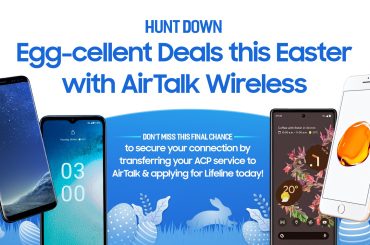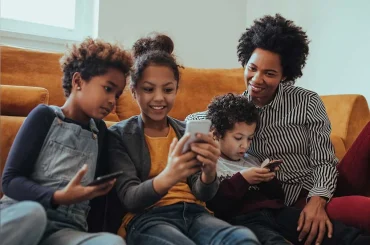The government’s Affordable Connectivity Program (ACP) provides subsidies to low-income households to assist in covering the cost of an internet connection. Families that meet specific income requirements are eligible for this program, which can help them save money on a monthly basis. Let’s learn about Affordable Connectivity Program eligibility via this post.

Your Household Income Is At Or Below 200% Of The Federal Poverty Guidelines
If your income is at or below 200% of the U.S. Federal Poverty Guidelines, you can join the ACP program. If you have 4 people in your home and live in California, for example, your household income must be less than $55,500 per year to qualify for the ACP.
Participant In One Of The Federal Assistance Programs
You must enroll in SNAP, Medicaid, Federal Public Housing Assistance, SSI, WIC, or Lifeline to meet the Affordable Connectivity Program eligibility.
1. Lifeline
The Lifeline program is a government-funded initiative that assists low-income families with getting phone service. Thus, you can apply for a cheap phone plan through your phone carrier or the government’s Universal Service Administration Company if you qualify for the Lifeline program (USAC).
To join the Lifeline program, you must show proof of income and residency. You can apply online, over the phone, or in-person at a telephone provider or a USAC office near you. In addition, you can also sign up with an internet provider like Airtalk.

2. SNAP
The Supplemental Nutrition Aid Program (SNAP) is a federal assistance program that assists low-income people and families in purchasing food. The United States Department of Agriculture administers SNAP (USDA).
Each month, more than 40 million low-income individuals and families receive food assistance through SNAP. Thus, SNAP eligibility depends on a number of variables, including household income, assets, and family size.
People can purchase food with SNAP benefits at grocery shops, convenience stores, and farmers’ markets. The number of SNAP benefits received depends on the size and income of the household.
If you want SNAP assistance, you must apply through your state. SNAP application methods vary by state. However, you will normally need to complete an application and submit it to your local SNAP office. You may need to produce proof of your eligibility for SNAP assistance. You’ll get an Electronic Benefits Transfer (EBT) card once your application is accepted. Then, you may use it to buy SNAP-eligible food at participating locations.
For more information on SNAP and how to apply in your state, please visit the SNAP website.

3. Medicaid
Medicaid is a government insurance program. It assists low-income people in paying for medical treatment. Importantly, it is a federally funded healthcare program that is available in all 50 states.
Medicaid covers a variety of medical services, but not all medical treatments. In addition, each state’s Medicaid program has its own set of requirements.
It can assist you in covering the costs of doctor’s visits, hospital stays, medicines, and other healthcare services. Long-term care, such as nursing home care, may also be in Medicaid. In addition, Medicaid is a federal-state partnership, and each state has its own set of regulations for who qualifies for the program and what treatments are covered.
If you think you might be eligible for Medicaid, contact your state Medicaid agency or visit the Medicaid website to learn more and apply. Besides, you can also find information about this program in your state’s Health Insurance Marketplace.

4. Federal Public Housing Assistance
The HUD-sponsored Federal Public Housing Aid program provides financial assistance. It aims at low-income households that are having trouble paying their rent.
Local housing agencies (HAs), which are either congressionally established or state/local public institutions, administer public housing. HUD’s public housing program is administered through roughly 3,300 HAs. Then, residents, low-income representatives, and other interested parties make up the governing board of each HA.
Federal Public Housing Assistance is an excellent option for purchasing a home without breaking the bank. The application procedure is straightforward, and you might be accepted in a matter of minutes. Finally, to learn more about Federal Public Housing Assistance and how to apply, contact your local housing authority.
5. SSI
Supplemental Security Income (SSI) is a financial support program for people who have handicapped, blind, or elderly. Because SSI is a federally financial program, it is available to people in all 50 states. You must fulfill certain conditions to be eligible for SSI payments. The condition may be being unable to work due to a disability and having limited income and resources.
The application process for SSI is relatively simple. Firstly, you can apply for Social Security benefits online or over the phone. You can also apply in person at your nearest Social Security office. Secondly, you’ll have to show evidence of your disability, income, and assets. Finally, if you are qualified for SSI benefits, the government will send you monthly payments.

6. WIC
WIC (Women, Infants, and Children) is a government-supported nutrition program. It assists low-income pregnant women and mothers of small children in eating well and staying healthy.
Nutrition counseling and instruction, as well as breastfeeding assistance and connections to other health and social services, are all available via WIC. In addition, WIC clients also receive food coupons for infant formula, cereal, eggs, milk, and fresh fruits and vegetables.
Since 1974, the WIC program has assisted millions of women and children in obtaining the nutrition they require to be healthy. Then, nearly 8 million individuals enrolled in the WIC program in 2016.
You must be a pregnant woman, a mother of a kid under the age of five, or a one-year-old infant to be eligible for WIC. Additionally, you must also have a low income, which means your household income must be less than 185 percent of the federal poverty level. WIC applications are available through your local health department or WIC facility.

Participants Of Tribal Specific Programs
If you’re a member of one of the Tribal-specific programs. It can be the Bureau of Indian Affairs General Assistance, Tribal TANF, or the Food Distribution Program on Indian Reservations. As a result, you might save up to $75 per month on internet access via Affordable Connectivity Program eligibility.

1. Bureau of Indian Affairs General Assistance
The Bureau of Indian Affairs (BIA) General Support program provides temporary financial assistance to qualifying tribes and their people. What’s more, individuals and families that are unable to satisfy their basic requirements, such as food, clothes, and shelter, will benefit from the program.
You must be a member of a federally recognized tribe to qualify for BIA General Assistance. You must also meet specific income standards and have a particular quantity of assets.
If you qualify for BIA General Help, you may be eligible for financial assistance for up to 12 months. The amount of help you get will depend on your income and assets.
For additional information on how to apply for Bureau of Indian Affairs General Assistance, please visit their website. Furthermore, you may also get more information about the program and how to apply by contacting their office directly.
2. Tribal TANF
Tribal TANF is a financial aid program for low-income families. The Department of Health and Human Services administers it, and it offers it to qualifying Native American tribes. In this program, food, clothing, and shelter are some of the basic needs that can assist families. Other services, such as career training and child care, are also possible.
Please contact your local tribe or the Department of Health and Human Services if you want to apply for Tribal TANF. On the Bureau of Indian Affairs’ website, you may discover contact information for your tribe’s welfare office.
3. Food Distribution Program on Indian Reservations
Food aid serves qualified Native Americans living on or near Indian reservations through the Food Distribution Program on Indian Reservations. The federal government is financing this program. The Food and Nutrition Service of the United States Department of Agriculture administers the program, which is one of the country’s major nutrition aid programs.
The Food Distribution Program on Indian Reservations (FDPIR) distributes a monthly food supply to qualified families. The package includes cereals, pork, chicken, and fish, as well as canned fruits and vegetables, dry beans and peas, and peanut butter.
You must satisfy specific qualifications to be eligible for the FDPIR, including being a member of a federally recognized tribe and residing on an Indian reservation. Besides, if you are a descendant of a member of a federally recognized tribe, you may also be eligible. Visit the USDA website for additional information on qualifying requirements.

4. Head Start
Infants, toddlers, and preschool-aged children from low-income families benefit from Head Start programs, which help them become ready for school. Centers, family child care, and children’s homes are all places where services are delivered. Furthermore, Head Start programs also encourage strong connections between parents and other key family members, with an emphasis on family well-being. Parents take on leadership roles and have a voice in how the program runs.
Head Start programs provide a number of services to help children thrive in a healthy learning environment, including:
- Early learning and development: Individualized learning experiences promote children’s preparation for school and beyond. Children develop in many areas of development through connections with people, play, and planned and spontaneous instruction. Besides, social skills, emotional well-being, language and reading abilities, math ideas, and scientific concepts are among them.
- Health: Early learning opportunities that encourage children to fully explore and experience their world necessitate good health and physical development. Indoors and out, Head Start programs provide a safe and healthy learning environment.
- Family well-being: Program services are provided to parents and families. It will promote family well-being and help them accomplish family objectives such as home stability, further education, and financial security. Then, families are involved in their children’s learning and development through programs that encourage and improve parent-child interactions.

Head Start services are provided by 1,600 agencies in local areas. Non-profit organizations, schools, and community action groups manage the majority of Head Start programs. Every year, they serve over a million children in every state and territory in the United States.
Finally, for further information about the Head Start program, you can check it out on the Office of Head Start website.
Participants In The National School Lunch Program Or The School Breakfast Program
You are most likely qualified for the Affordable Connectivity Program eligibility if you already participate in the National School Lunch Program or the School Breakfast Program. Here’s all you need to know about these 2 programs.
1. National School Lunch Program
The National School Lunch Program is a nationally-funded meal program that provides low-income students with free or reduced-price meals. The program began in 1946 and is now available in over 100,000 schools across the United States.
Lunches supplied under the National School Lunch Program must adhere to strict nutritional guidelines, which include calorie, fat, and salt limitations. If a family’s income falls below a specific threshold, children can get free or reduced-price meals under the program.
If you’d like to apply for the National School Lunch Program, go to the US Department of Agriculture’s website. After that, you’ll be able to fill out an application and submit it for approval. You will be eligible to begin getting benefits from the program after your application has been approved.

2. School Breakfast Program
The school breakfast program is a federally financed food program that offers kids in public and nonprofit private schools free or reduced-price meals. The initiative aims to guarantee that all kids get a nutritious meal to start their day. Thus, this program can help them perform better academically and learn more effectively.
Cereal, eggs, toast, oatmeal, and other nutritional breakfast options are available through the School Breakfast Program. Thus, students’ academic performance has been demonstrated to increase when they participate in the program, as well as their dietary needs. Finally, visit https://www.fns.usda.gov/school-breakfast-program for additional information about the School Breakfast Program.
Get a Federal Pell Grant
The Federal Pell Grant is a type of financial aid that assists students who need help paying for college. The gift is based on financial necessity and does not require repayment. Students who qualify can get up to $5,500 every year.
First, you must fulfill certain conditions to be eligible for a Federal Pell Grant. Second, the applicant also needs to enroll in a degree or certificate program that is qualified, and you must show financial need. And third, you must also be a United States citizen or an eligible non-citizen with a valid Social Security number.
One of the most common types of financial help is the Federal Pell Grant. In reality, more than half of all undergraduate students get Pell Grant funding in some way. Fill out the Free Application for Federal Student Aid if you need to apply for a Federal Pell Grant (FAFSA). The FAFSA is the application that determines whether or not you are eligible for any type of financial aid, including the Pell Grant.

Frequently Asked Question About ACP Eligibility
Here are the frequently asked questions about Affordable Connectivity Program eligibility that you may concern about:
Breakfast and lunch are provided free of charge to all students at my child’s school. Do we meet the requirements?
A home may enroll in the Affordable Connectivity Program if their school participates in the Community Eligibility Provision. Besides, if the household has applied for and been qualified for benefits under the free and reduced-price school lunch or school breakfast programs separately. Schools can provide free lunch or breakfast to all students, regardless of income, through a program other than the Community Eligibility Provision. For instance, some of these programs are COVID-19 waivers extending the Seamless Summer Option (SSO) or Summer Food Service Program (SFSP). As a result, the household would not be eligible for the free and reduced-price school lunch or school breakfast program by virtue of an extension of the SSO or SFSP.
Can I receive both the enhanced Tribal Lifeline Benefit and the $75 Affordable Connectivity Program each month?
Yes. Both the $34.25 Lifeline Tribal benefit and the $75 Affordable Connectivity Program benefit are available to qualified households on Tribal territories. As long as the provider participates in the Affordable Connectivity Program, they can be applied to the same qualified service. In addition, they can separately qualify for Lifeline service and an internet subscription with the same or other providers. For instance, an eligible household might have a Lifeline-supported mobile service and a separate Affordable Connectivity Program-supported home internet subscription.
Is it possible to qualify for the Affordable Connectivity Program if I owe a provider money?
Yes, the benefit is available to qualifying consumers who have a past-due debt or a balance in collections.
Conclusion
Do you know you can receive a free iPhone 6s if you qualify for the Affordable Connectivity Program Eligibility? AirTalk Wireless is an ACP provider, and each customer applying at Airtalk can receive a free phone with a variety of options, from basic to advanced models, as well as free internet services based on your application option. Don’t hesitate to contact AirTalk now for the best support and consultation.






28 Comments
Your latest blog post was truly inspiring and had some great insights. I can’t wait to see what else you have in store.
Thank you for your support. We would love to have you as our valued customer and encourage you to apply now! To apply online please visit https://airtalkwireless.com/apply and enter your zip code and email address to get started. Then follow the steps to complete your application.